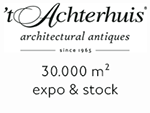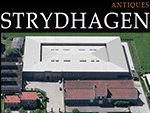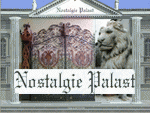Madonna And Child, Workshop Of Andrea Del Sarto (Florence 1486 - 1530)
Madonna and Child Workshop of Andrea del Sarto, pseudonym of Andrea d'Agnolo di Francesco (Florence 1486 - 1530)
Attributable to Jacopo di Giovanni di Francesco, known as Jacone (Florence, 1492 - 1554)
Oil on panel (72 x 56 cm. - In frame 109 x 94 cm.)
Provenance: Sotheby's New York, 29.01.2016, Master Paintings Sale, lot 426, as Jacopo di Giovanni di Francesco, known as Jacone (Florence, 1492 - 1554) - estimate ($30,000 - $40,000) - LINK
Full details of the work (click HERE)
The painting in question, which can be dated to the mid-sixteenth century, depicts the Madonna lovingly supporting the Infant Jesus with both hands. The infant, who looks directly at us with a knowing yet timid smile, is tenderly clinging to his mother, using her left leg for support. He appears distracted by our presence and his sudden twist brings the painting to life. The plastic style, incisive but formally harmonious and well balanced, allows us to categorise the painting as one of the most beautiful works of the Florentine Renaissance.
By dwelling on the details it is easy to trace the work back to the workshop of Andrea del Sarto (Florence 1486 - 1530), one of the most outstanding exponents of this period, defined by Vasari as a painter ‘without errors’, praising his formal perfection, speed and confidence of execution. His style, characterised by a notable compositional balance and a high level of formal control, had a great influence on 16th century Florentine painters, so much so that it was considered fundamental for the genesis of the ‘manner’, combining in an exceptionally harmonious way the pyramidal scheme typical of Raphael's Madonnas with the monumentality of the figures derived from Michelangelo.
Focusing on the refinement of the poses, especially that of the baby Jesus, and on the vivacity of the chromatic material, the sacredness of the image is softened by the spontaneous gestures between the two characters, which make one think of a scene from everyday life, rather than a religious image. The graceful expression of the child, who looks at the observer with a lively air, also testifies to the domestic destination of the work. In works like this, the new approach to sacred art was substantially contained, deeply immersed in the innovative spirit of the new Florentine ruling class, aimed at reconciling the religious aspect with the profane one.
Specifically, the painting in question, to be placed around the first half of the sixteenth century, was sold by Shoteby's New York (Master Paintings & Sculpture Day Sale - 29 January 2016), not yet restored, as attributed to Jacopo di Giovanni di Francesco, known as Jacone (Florence, 1492 - 1554), who trained in the workshop of Andrea del Sarto, of whom he was a close friend and collaborator. Jacone, who was an exponent of a unique and eccentric style of painting and was one of the most creative artists trained in Andrea del Sarto's studio, clearly shows in our painting the influence of his master Andrea del Sarto, but also that of his contemporaries, Rosso Fiorentino and Pontormo, who were also pupils of Del Sarto.
Although his identity as an artist is less defined than that of some of his contemporaries, Jacone was well known to Giorgio Vasari, who described in detail his dissolute lifestyle, as well as his fantastic graphic ability. Given the similarity of the drawing style and the use of colour, we are led to believe that the painting in question was painted by Jacone immediately after the death of his master Andrea, to whom he was very attached and whom he greatly admired, therefore around 1530-40 (as also hypothesised by Christie's), chronologically close to the large altarpiece of the Madonna and Child with Saints Francis and Sebastian (Pinacoteca Comunale, Città di Castello, Umbria), where the facial prototypes of the Virgin and Child are similarly distinct.
Vasari notes that the artist produced a number of depictions of the Madonna, which were quickly exported to France by expert Florentine mediators, no doubt to satisfy the taste in that country for such depictions, motivated by his master del Sarto's brief stay there in 1518-19.
ADDITIONAL INFORMATION:
The painting is sold with a pleasant frame and is accompanied by a certificate of authenticity and a descriptive iconographic card.
We organise and take care of the shipment of the purchased works, both in Italy and abroad, through professional and insured carriers.
It is also possible to see the painting in the gallery in Riva del Garda, we will be happy to welcome you and show you our collection of works.
Contact us, with no obligation, for any further information.
Follow us also on:
https://www.instagram.com/galleriacastelbarco/?hl=it
https://www.facebook.com/galleriacastelbarco/
|




































